As businesses increasingly seek efficient and cost-effective solutions, the popularity of Software as a Service (SaaS) has soared. As a professional, you certainly feel the urgency of seamless interaction between two businesses. You need to decode what is B2B SAAS keeping its grip.
Eventually, it will impress any executives working in the Business-To-Business industry. This essential component of the modern B2B business model comes with scalable and customizable software solutions. So, join us as we have assembled a comprehensive understanding of this type of solution.
First, let’s explore the core concepts for which we need to define the term and know why it matters in modern enterprises. This insight will provide significant benefits and scope for greater usage.
What is B2B SaaS?
The full form of B2B is business to business and the full form of SaaS is software as a service. Software-as-a-service that aims to assist B2B business model at its core is known as B2B SaaS.
When it comes to defining the concept, core concepts and applications are mandatory. A comparative analysis would be handy to understand it clearly, leading to utilizing it the right way.
1. Software as a Service and Its Core Characteristics
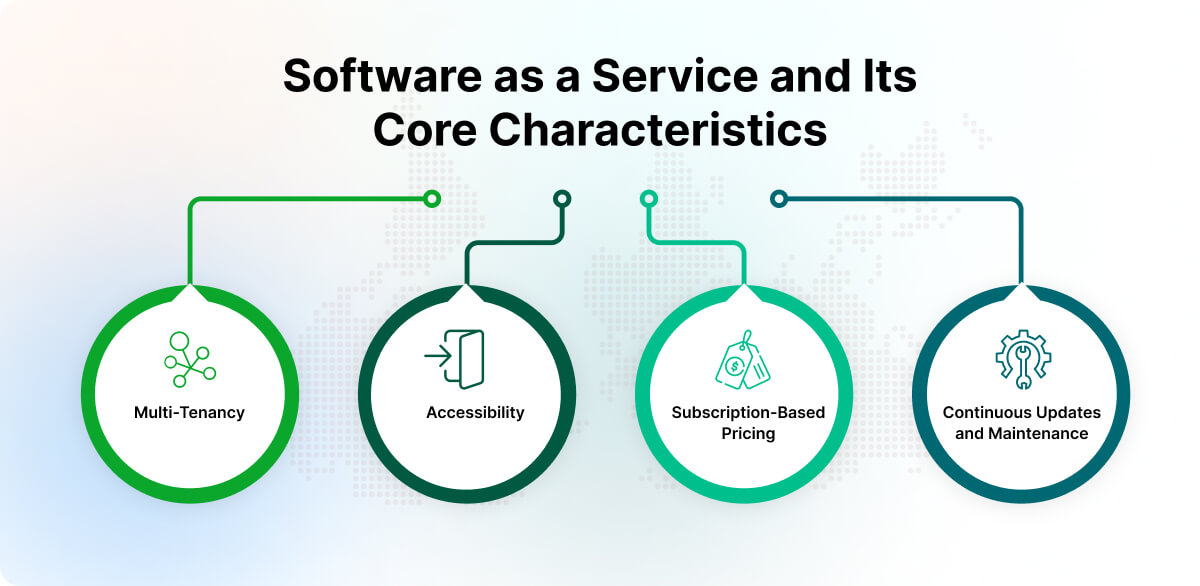
Software as a Service is a software distribution model where applications are hosted by a service provider. They are accessed over the internet by users, eliminating the need for local installation and maintenance. Now let’s explore the core characteristics of SaaS:
- Multi-Tenancy: They are designed to serve multiple customers (tenants) from a single instance of the software. This allows for efficient resource utilization and scalability while ensuring data isolation and security for each customer engagement.
- Accessibility: They are accessed through web browsers or dedicated client interfaces, enabling users to access the software from anywhere with an internet connection. This accessibility fosters remote work, collaboration, and real-time data access.
- Subscription-Based Pricing: SaaS operates on a pay-as-you-go model, where customers pay a recurring subscription fee for using the software. This eliminates the upfront costs associated with traditional software licensing, making it more cost-effective for businesses.
- Continuous Updates and Maintenance: SaaS providers handle software updates, bug fixes, and maintenance tasks, relieving customers from the burden of managing and deploying software updates. This ensures that users always have access to the latest features and security patches.
2. SaaS Applications Designed for B2B Businesses
- Customer Relationship Management (CRM): B2B CRM platforms help businesses manage and analyze customer interactions, sales pipelines, and marketing campaigns. They enable businesses to track customer data, streamline communication, and optimize sales processes for enhanced customer relationship management.
- Project Management: B2B project management tools assist businesses in planning, organizing, and tracking projects. These tools facilitate collaboration among team members, task assignment, progress monitoring, and resource allocation, ensuring efficient project execution and delivery.
- Human Resources Management: B2B HR management software automates various HR functions such as employee onboarding, attendance tracking, performance evaluation, and payroll management. These solutions streamline HR processes, improve employee engagement, and enhance workforce productivity.
- Financial Management: B2B financial management software offers tools for accounting, budgeting, invoicing, and financial reporting. These applications enable businesses to manage their finances effectively, track expenses, generate accurate financial statements, and streamline financial operations.
3. B2B SaaS Vs Software Models
- Customization and Integration: This type of solution often provides customization options to meet specific business requirements. They can integrate with other software systems to enable seamless data flow and process automation.
- Enterprise-Grade Security: These applications prioritize robust security measures to protect sensitive business data. They implement encryption, secure data storage, regular backups, access controls, and compliance with industry standards.
- Scalability and Elasticity: These applications are designed to scale effortlessly, accommodating growing business needs and fluctuations in demand. They can handle increased user loads and data volumes, ensuring optimal performance and user experience during periods of growth.
- Vendor Management and Support: These providers offer ongoing support, maintenance, and updates for their applications. They handle software upgrades, bug fixes, and feature enhancements, allowing businesses to focus on their core operations.
Advantages of B2B SaaS
Now you are going to have a broader view of why it matters and why you should give it a try. Let’s step into the most necessary section in the ongoing discussion:
1. Primary Benefits of B2B SaaS Solutions
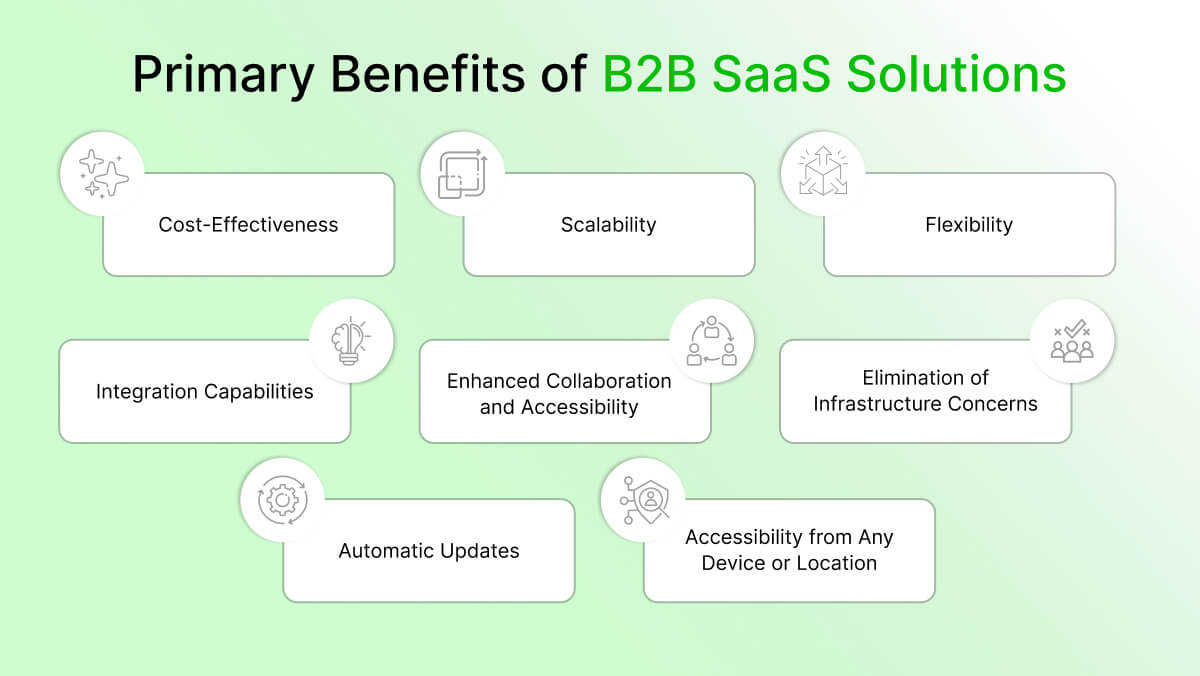
- Cost-Effectiveness: It eliminates the need for upfront infrastructure investment and reduces IT maintenance costs. With pay-as-you-go pricing models, businesses can scale their usage and expenses according to their needs, avoiding excessive spending on unused resources.
- Scalability: This type of solution offers scalability, allowing businesses to easily adjust their software capabilities as their operations grow or change. The cloud-based nature of SaaS enables seamless expansion or downsizing of resources.
- Flexibility: These solutions provide flexibility through customizable features and configurations. Businesses can tailor the software to align with their specific requirements. This flexibility empowers organizations to optimize operations and adapt the software to their unique business processes.
- Integration Capabilities: These solutions are designed to integrate seamlessly with other business systems and applications. This enables data exchange, streamlines workflows, and facilitates the creation of a cohesive technology ecosystem.
- Enhanced Collaboration and Accessibility: It promotes collaboration by providing real-time access to data from any device or location with an internet connection. This accessibility fosters remote work and enables seamless collaboration across geographies and time zones.
- Elimination of Infrastructure Concerns: With This type of solution, businesses no longer need to worry about hardware infrastructure, data centers, or server maintenance. The responsibility for infrastructure management lies with the SaaS provider.
- Automatic Updates: The providers handle software updates to always access the latest features, bug fixes, and security patches without any manual intervention. This saves time and effort to leverage the latest technology advancements effortlessly.
- Accessibility from Any Device or Location: The applications are accessible from laptops, tablets, or smartphones and any location with an internet connection. This flexibility enables remote work, enhances productivity, and facilitates seamless collaboration across teams.
2. Impact of B2B SaaS on Businesses
Stat 1: According to a study conducted by Blissfully, companies that adopted SaaS applications experienced an average productivity gain of 20%.
This increase in efficiency can be attributed to factors such as streamlined workflows, automation of repetitive tasks, and improved collaboration facilitated by These solutions. With cloud-based accessibility and advanced features, employees can focus on core activities.
Stat 2: A survey by BetterCloud revealed that businesses using SaaS applications witnessed an average cost savings of 21% compared to on-premises software.
Eliminating the need for upfront hardware investments, infrastructure maintenance, and software upgrades, offers significant cost-effectiveness. The scalability and pay-as-you-go pricing models of This type of solution contribute to cost optimization and improved financial returns.
Stat 3: A study by Salesforce discovered that 85% of customers expect a seamless and consistent experience across multiple channels.
These solutions enable businesses to deliver personalized, omnichannel experiences to their customers. By leveraging CRM and customer engagement tools, companies can better understand customer needs, provide timely support, and improve overall satisfaction.
B2B SaaS in Sales and Marketing
As you step into the industry analysis, the following sectors are here for you to get a glimpse of the contribution.
1. Revolutionizing Sales and Marketing Processes of B2B SaaS
- Lead Generation: The platforms provide lead generation functionalities to capture and nurture leads effectively. These platforms offer lead scoring and lead tracking features to engage with potential customers at various stages of the sales funnel.
- CRM Systems: Its CRM systems centralize customer data, interactions, and sales pipelines. These platforms enhance sales productivity by organizing customer information, tracking deals, and automating sales processes.
- Marketing Automation: These platforms incorporate marketing automation tools that streamline marketing workflows. These tools automate repetitive tasks such as email campaigns, social media posting, and lead nurturing to focus on strategy and creative initiatives.
- Analytics: The platforms provide robust analytics capabilities to track and measure marketing and sales performance. These tools offer insights into lead generation, conversion rates, customer behavior, and campaign effectiveness.
2. Successful B2B SaaS Applications in Sales and Marketing
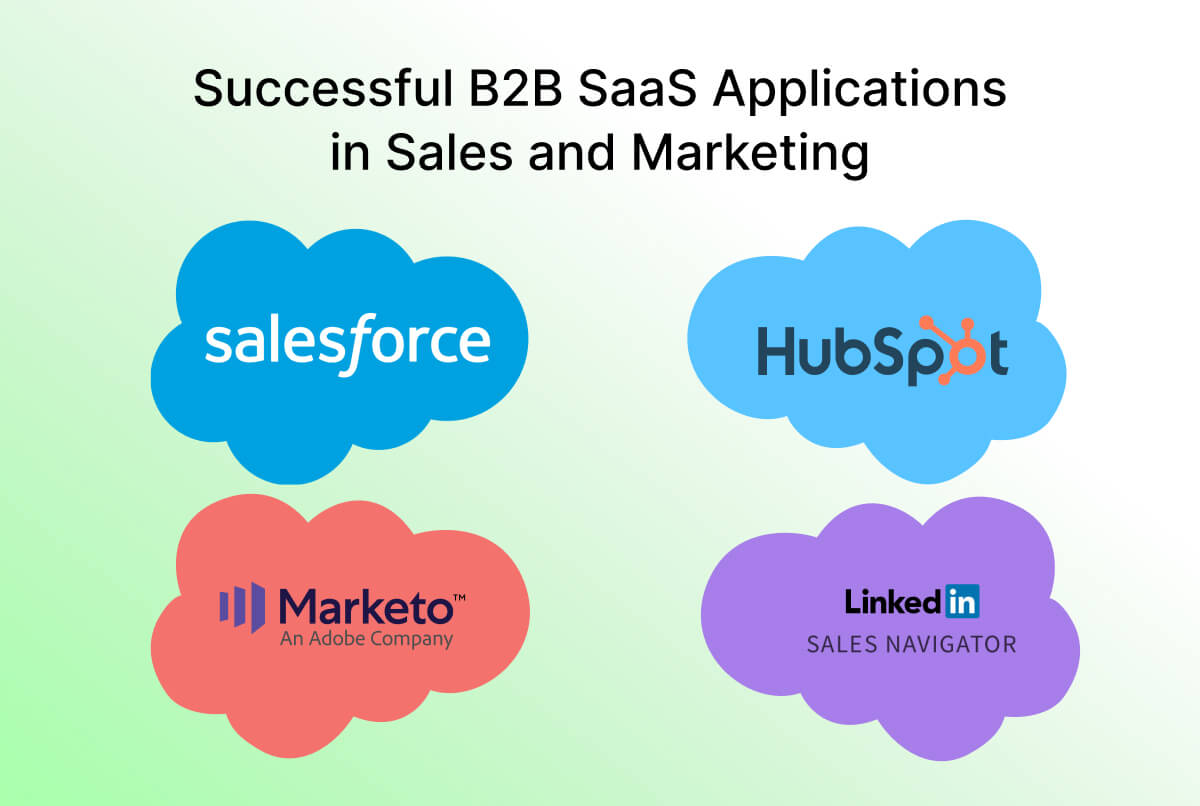
- Salesforce: A leading CRM platform that revolutionized the sales and marketing industry. Salesforce provides a comprehensive suite of tools for lead generation, CRM, marketing automation, and analytics to streamline their sales processes and drive revenue growth.
- HubSpot: This all-in-one inbound marketing and sales platform offers solutions from lead generation to analytics. HubSpot’s user-friendly interface and integration capabilities to automate and optimize sales and marketing activities.
- Marketo: A marketing automation platform that enables businesses to automate and optimize their marketing campaigns. Marketo offers features such as lead management, email marketing, social media marketing, and analytics.
- LinkedIn Sales Navigator: This is a B2B social selling tool that allows sales professionals to manage prospects on LinkedIn. It provides advanced search filters and lead recommendations to help sales teams engage with the right prospects effectively.
B2B SaaS in Project Management and Collaboration
Now let’s illustrate the role in facilitating productivity and seamless workflows. The following insights are poised as a better overview:
1. B2B SaaS in Enhancing Organizational Functionality
- Centralized Project Management: These tools provide a centralized platform to plan, track, and manage projects. These tools offer features like task assignments, progress tracking, and milestone management.
- Collaboration and Communication: These tools facilitate collaboration among team members by providing shared workspaces, and real-time communication channels. Features like discussion threads, and video conferencing enhance teamwork regardless of team members’ locations.
- Workflow Automation: The project management tools often include workflow automation capabilities. These tools streamline repetitive tasks, automate approvals, and trigger notifications, reducing manual effort and enhancing overall workflow efficiency.
- Resource Allocation and Tracking: These tools enable businesses to allocate and track resources effectively. These tools offer resource management features such as resource scheduling, workload balancing, and time tracking.
- Reporting and Analytics: The tools provide reporting and analytics features to get project progress, resource utilization, and performance metrics. It helps identify bottlenecks, track project success, and make data-driven decisions for future projects.
2. Popular Project Management Platforms and Team Collaboration Tools
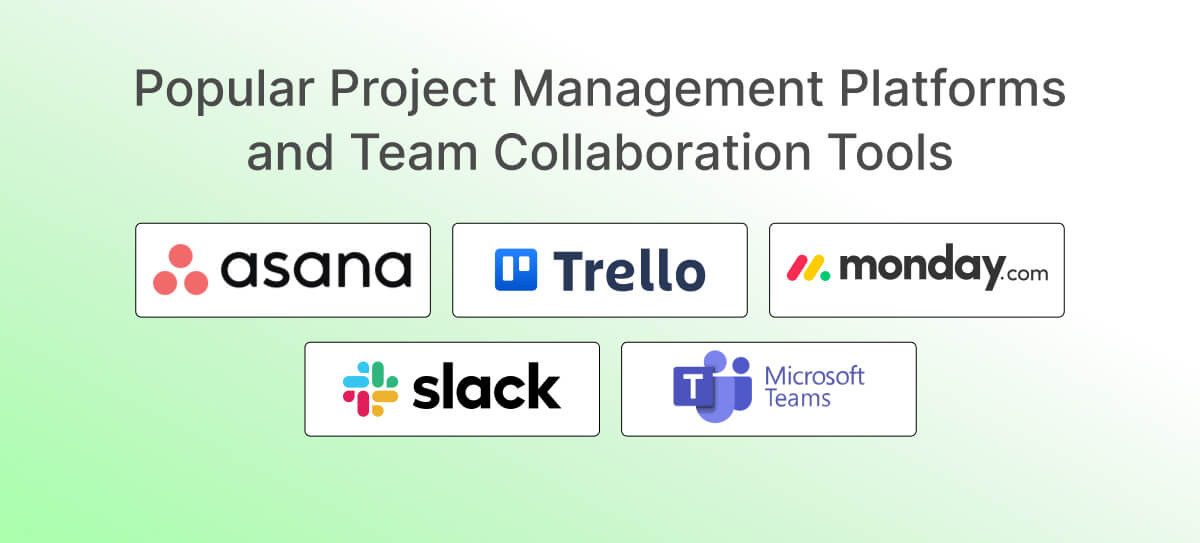
- Asana: Asana offers a robust project management solution with features such as task management, team collaboration, and project tracking. It enhances productivity by providing a centralized platform for teams to manage their tasks, communicate effectively, and track progress.
- Trello: Trello is a visual project management tool based on the Kanban methodology. It uses boards, lists, and cards to organize tasks and streamline team collaboration. With its intuitive interface, teams can easily track project progress, assign tasks, and share updates.
- Monday.com: This is a versatile team collaboration platform that allows teams to manage projects, track tasks, and automate workflows. It offers customizable boards and automation features, enabling teams to streamline their processes by automating repetitive tasks.
- Slack: Slack is a popular team communication and collaboration tool that centralizes communication channels, file sharing, and integration with other applications. It provides real-time messaging, collaboration channels, and file-sharing capabilities.
- Microsoft Teams: Teams is a comprehensive platform that integrates chat, video conferencing, file sharing, and project management features. With its integration with other Microsoft tools, it enhances productivity by facilitating uninteresting collaboration.
B2B SaaS in Human Resources and Talent Management
This is to demonstrate how HR processes are streamlined. Your recruitment, employee onboarding, performance appraisal, and training all will be in auto-pilot mode.
1. B2B SaaS Solutions in Streamlining HR Processes
- Recruitment: These applications like Workday and Greenhouse automate and streamline recruitment processes. It provides applicant tracking systems, resume parsing, candidate evaluation, and interview scheduling capabilities.
- Onboarding: Tools like BambooHR and Namely offer onboarding modules that streamline the process of employee documentation, task assignment, and new hire orientation. These applications automate onboarding workflows to minimize administrative overhead.
- Performance Management: Platforms such as SuccessFactors and 15Five provide performance management solutions. They simplify goal setting, performance tracking, feedback collection, and performance reviews.
- Employee Engagement: Platforms like Glint and Culture Amp offer employee engagement surveys, pulse check-ins, and feedback mechanisms. They gather employee feedback, measure engagement levels, identify areas for improvement, and implement strategies.
2. B2B SaaS in Talent Acquisition and Retention
- Improved Efficiency: The solutions automate and streamline talent acquisition processes, reducing manual effort, saving time, and improving efficiency in sourcing, screening, and hiring candidates.
- Enhanced Candidate Experience: These platforms provide user-friendly interfaces, personalized communication, and streamlined application processes, offering a positive candidate experience that reflects well on the employer brand.
- Data-Driven Decision-Making: The applications offer analytics and reporting that provide valuable insights into candidate pipelines, and performance data. This data-driven approach enables informed decision-making and continuous improvement of talent acquisition strategies.
- Retention Strategies: The solutions for talent management and engagement help organizations assess employee sentiment, and implement targeted retention strategies. This contributes to higher employee satisfaction, reduced turnover, and improved retention rates.
Key Considerations for Adopting B2B SaaS
Finally, it’s time to learn the critical factors businesses must evaluate before getting into the implementation stage. Take a deep dive into the section, and it will help you get a firm grip on your next activities.
Security and Data Privacy
You need to emphasize the paramount importance of data security and privacy measures. It will get everything in your control and you don’t have to be afraid of any reckless step.
1. Importance of Data Security and Privacy when Choosing B2B SaaS
- Protection of Sensitive Information: This is necessary to safeguard sensitive business information, customer data, and intellectual property. For example, encryption and access controls ensure that data is protected from unauthorized access, breaches, and cyber threats.
- Compliance with Regulations: Choosing this type of solution means adhering to relevant data protection regulations. They include the General Data Protection Regulation (GDPR) or the Health Insurance Portability and Accountability Act (HIPAA),.
- Trust and Customer Confidence: Selecting a provider with a strong track record in data security and privacy instills confidence in customers, partners, and stakeholders. It reinforces the trust they place in the organization’s ability to protect their data.
2. Industry Standards and Compliance Certifications
- ISO 27001: ISO/IEC 27001 is an internationally recognized standard that outlines best practices for an information security management system (ISMS). This ensures the security controls and data protection of the provider.
- SOC 2: Service Organization Control 2 is an auditing standard developed by the American Institute of Certified Public Accountants (AICPA). It evaluates the security, availability, processing integrity, confidentiality, and privacy of a service organization’s systems.
3.Best Practices to Ensure Data Protection
- Data Encryption: Implementing encryption techniques helps safeguard sensitive data from unauthorized access. Encryption converts data into unreadable formats that can only be decrypted with the appropriate keys.
- Access Control and Authentication: Employ strict access control measures to limit data access to authorized personnel. Enforcing the principle of least privilege grants employees access only to the data and systems they require for their roles.
- Regular Data Backups: Regularly backing up data ensures that in the event of a breach, system failure, or data loss, organizations can restore their data to a previous state. The restoration process should be tested periodically to verify its effectiveness.
Integration and Customization
Here are the needs for seamless integration with existing systems and the ability to customize with specific requirements. Let’s discover the regulations so that nothing gets skipped out:
1. Integration between Existing Systems and B2B SaaS Applications
- Data Flow and Consistency: Uninterrupted integration ensures smooth data flow between existing systems and the applications. It enables real-time synchronization to maintain data consistency and accuracy across platforms.
- Process Efficiency: Integration streamlines workflows by automating data transfer to achieve greater process efficiency. For example, integrating a CRM system with this type of marketing automation tool allows seamless lead management.
- Comprehensive Insights: Seamless integration facilitates data consolidation from various sources to gain comprehensive insights. By combining data from different systems, organizations can generate dashboards that provide a holistic view of their operations.
- Enhanced User Experience: Integration between systems creates a unified and seamless user experience. Users can interact with data from different platforms without the need for multiple logins or manual data transfer.
2. Importance of Customization Options in B2B SaaS Platforms
- Alignment with Business Processes: Customization options in These platforms allow businesses to align the software with their specific requirements. Tailoring the platform to match existing workflows can save time and resources.
- Enhanced User Adoption and Satisfaction: Customization empowers users by providing a personalized and intuitive experience. Tailoring software to preferences helps employees to achieve higher productivity.
- Scalability and Future Growth: Customization options in These platforms allow for scalability and adaptability. By tailoring the platform to current requirements, businesses can avoid the need for frequent software replacements.
Vendor Selection and Evaluation
It will guide you in the process of selecting trustworthy tools. You will be in safe hands, and it undoubtedly is a great relief when you have a big and complex work chain.
Step-by-step Guide for Selecting the Right B2B SaaS Vendor
- Define Requirements: Identify your specific business needs and goals. Determine the functionalities, integrations, and support required from the vendor.
- Research and Shortlist: Conduct market research, read reviews, and seek recommendations to create a shortlist of potential vendors that align with your requirements. Consider factors like reputation, reliability, security measures, and industry experience.
- Evaluate Vendor Offerings: Assess each vendor’s offerings, product features, scalability, and pricing models. Evaluate the vendor’s track record, financial stability, and customer references to ensure their capability to meet your needs.
- Engage in Dialogue: Engage in discussions with the shortlisted vendors to gain insights into their implementation process and ongoing maintenance. Evaluate their willingness to address concerns and commitment to good customer experience.
- Conduct Demos: Request product demos to assess the usability, user interface, and compatibility with your business processes. Involve key stakeholders and users in the evaluation process to gather different perspectives.
- Seek Customer References: Ask the vendor for customer references and contact existing clients to understand their experience with the vendor’s product, support, and overall satisfaction.
- Consider Total Cost of Ownership: Evaluate the pricing structure, including upfront costs, subscription fees, and any additional charges for customization, integrations, or support. Assess the long-term value and return on investment the vendor offers.
Tips for Evaluating the Right B2B SaaS Provider
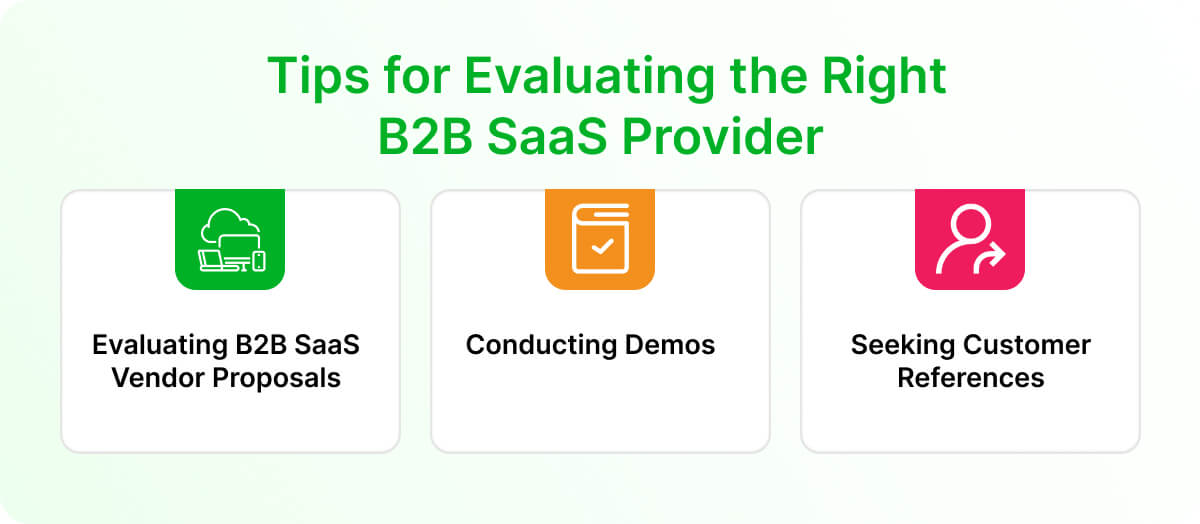
- Evaluating B2B SaaS Vendor Proposals: Create a checklist that outlines your needs in terms of functionality, scalability, security, support, and pricing. Look for indicators of their long-term viability, such as their client base, funding history, and market presence.
- Conducting Demos: Develop a set of use cases that reflect your specific business requirements. Share it with the vendors before the demo to let them prepare relevant demonstrations.
- Seeking Customer References: When seeking customer references, request examples of customers who have similar use cases. Ask about the vendor’s post-implementation support and ongoing customer service initiatives.
All in all, B2B SaaS holds immense transformative potential for businesses serving businesses. Automation in operation is just one of them, but not all of it. So, if you wish to utilize what is it going to come up with, you need to get used to these smart business solutions right now.
Check also: Level Up Your Cloud Game: IaaS vs PaaS vs SaaS
This is Kawser Md Sayem, and I would like to introduce myself as a content writer. It has been five years since I began my professional writing journey. By this time, I have had the pleasure of working in unidentical industries like publishing, information technology, entertainment, and education
 SAAS
SAAS






